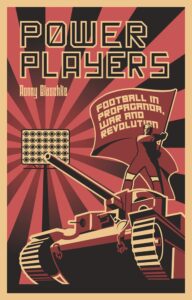 Dougie and Eddy Brimson’s first book of their Hooligan series sets out to explain the phenomenon of football hooliganism; “who causes violence, why, how and when they do it; about what can be done and by whom to try and stop it” and it is also a robust defence of football fans against lazy journalism and stereotyping.
Dougie and Eddy Brimson’s first book of their Hooligan series sets out to explain the phenomenon of football hooliganism; “who causes violence, why, how and when they do it; about what can be done and by whom to try and stop it” and it is also a robust defence of football fans against lazy journalism and stereotyping.
It delivers on all those points and more, but if you want imagery or Cantona-esque philosophy you’ve got off at the wrong tube station. Check over your shoulder for the spotters from the local mob and quickly head back to home turf.
However, if you stick it out on rival territory what you will find is a knowledgeable account of the experience of the football fan and the hooligan following their team home and away and being subjected to the heavy, prejudiced and uninformed hand of the police, media and the FA.
They try to explain that the catalyst that turns a fan into a hooligan can be an instantaneous and unexpected emotion rather than a predisposition and that hooligans and fans both care passionately about their club and its reputation; the difference being that one is on the field and the other is off it.
Their arguments are cogent and, despite their personal experiences, the authors are careful not to glorify the violence and, for every type of hooliganism they recollect, they also provide practical solutions to the problem that should embarrass those promoting knee-jerk reactions in today’s newspapers nearly 17 years later.
I’m reviewing a book written in 1996 under the lights of my 2012 Christmas tree, 2 months after the latest Hillsborough Enquiry found South Yorkshire Police largely culpable for the disaster, 6 weeks after one of my team’s fans shoved over an opposition goalkeeper in his own 6 yard box, the national team captain recently found guilty by the FA of racially abusing a fellow professional and racist abuse of players regularly in the headlines. It’s easy to conclude that much of the authors’ judgement of police, fans and the future of hooliganism is unerringly accurate. Which, given the enormous changes experienced by the game and its supporters since this book was written, is a significant achievement.
Of course, because it was written when the early-90s modernisation of the game was relatively fresh there are, what today may seem anachronistic views; longing for “male-dominated environment we grew up in and fell in love with” and a naïve view of what is and isn’t racist, but there is more than enough forward thinking elsewhere in the book to let these pass as “of-the-time”.
I haven’t yet read the rest of their series; I will in the New Year, confident that I may not agree with their opinion of fighting as a rite of passage nor the significance of the activities of football hooligans – my experience (as a fan of a notoriously supported team in the 70s and 80s) was that, for every fight there were 100 stand-offs where badly-dressed youths bounced around in front of opposing gangs, inviting them to a fight and backing off when they advanced, only for the scene to recur until everyone involved presumably got bored and went to the pub to exaggerate about it. But I will undoubtedly respect the knowledge and common-sense that the authors bring to the debate that they correctly predicted will continue to this day.
If only their judgement of what constitutes “the most famous diving header of all time” was as perceptive. Even up North we had TVs by the time of the 1972 FA Cup Final. No excuses.
Paul Gowland
 Football is increasingly becoming an instrument of political power.
Football is increasingly becoming an instrument of political power. Dougie and Eddy Brimson’s first book of their Hooligan series sets out to explain the phenomenon of football hooliganism; “who causes violence, why, how and when they do it; about what can be done and by whom to try and stop it” and it is also a robust defence of football fans against lazy journalism and stereotyping.
Dougie and Eddy Brimson’s first book of their Hooligan series sets out to explain the phenomenon of football hooliganism; “who causes violence, why, how and when they do it; about what can be done and by whom to try and stop it” and it is also a robust defence of football fans against lazy journalism and stereotyping.